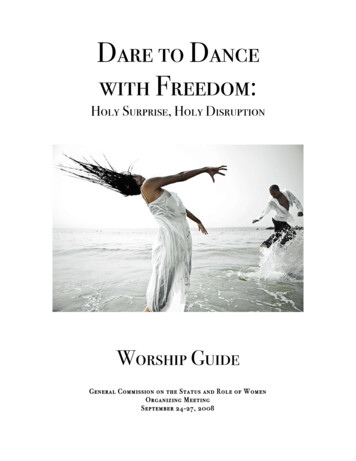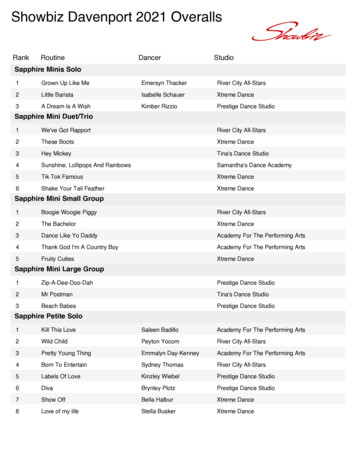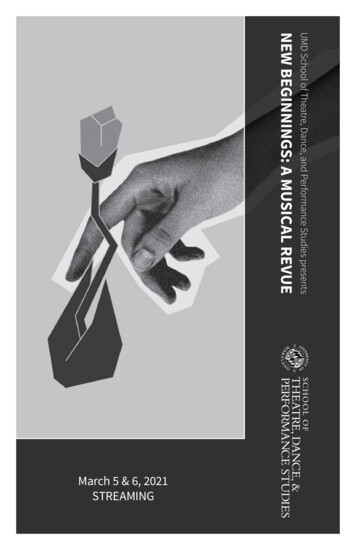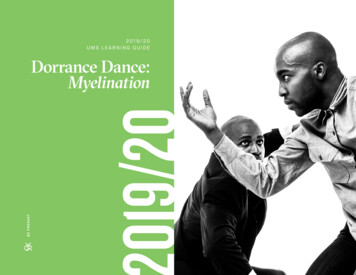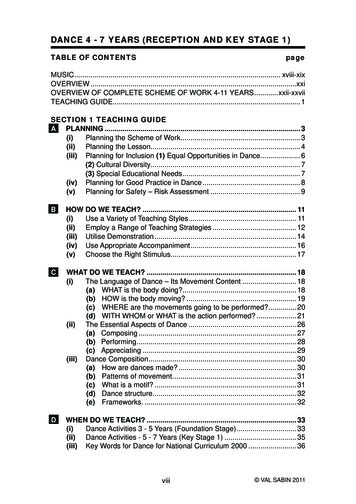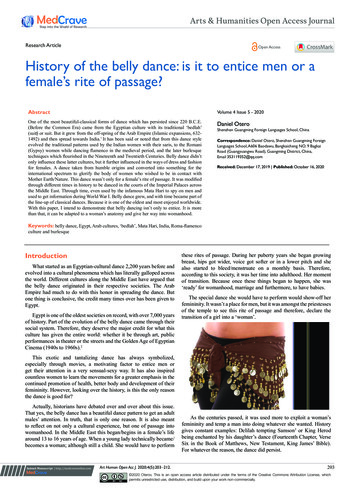
Transcription
THE HISTORY OF MODERN DANCEBallet Austin’s Michelle Thompson and Frank ShottCompiled and edited by Pei‐San Brown, Community Education Director, Ballet Austin‐The Pioneers of Modern DanceModern Dance was born in America duringthe turn of the 20th century when a number ofchoreographers and dancers rebelled againstthe two forms of dance that were prevalent atthe time, ballet and vaudeville. They rejectedwhat they interpreted as the rigid andimperialistic nature of ballet, and they wantedto be taken seriously as artists rather than beseen simply as entertainers. Loie Fuller,Isadora Duncan, Ruth St. Denis, and TedShawn are considered to be the pioneers ofmodern dance in America.In 1891, Loie Fullerbegan experimentingwith the effects ofgas lighting on hersilk costumes. Fullerdeveloped a form ofnatural movementand improvisationtechniques that wereused inLoie Fuller in La Danse Blanche circa 1896conjunction with her revolutionary lightingequipment and translucent silk costumes.Fuller was an inventor and stage craftinnovator who held many patents for stagelighting, including the first chemical mixesfor gels and slides and the first use ofluminescent salts to create lighting effects.Most of the movement was performed withthe arms, as Fuller had minimal dancetraining. She emphasized visual effect ratherthan storytelling or expressing emotions.Considered the founding mother of Americanmodern dance, Isadora Duncan was largelyself‐taught. She presented her firstrecitals in 1898, and by 1900 she was inEurope, where she wouldspend most of her remaining life and win thegreatest acceptance. Duncan was trulyrevolutionary. She discarded the corset,slippers, and tutu of conventional ballet dress,adoptinginstead tunicsthatfreed the bodyand revealed itsmovement.She usedmusic byChopin,Beethoven,Gluck, Wagner,and otherfirst rankcomposers.Isadora Duncan at the Parthenon TheaterShe danced on concert stages and in operahouses. She spoke of her dancing not asentertainment but as art with a high moralpurpose. Most of all, she insisted upon theessence of dance as movement. Hervocabulary was simple but performed with amusicality, dynamic subtlety, and charismathat made it powerfully expressive. In 1904,Duncan established her first school of dancejust outside of Berlin, where she began todevelop her theories of dance education andto assemble her famous dance group, laterknown as the Isadorables. Between 1904 and1907, Duncan lived and worked in Greece,Germany, Russia and Scandanavia.Ruth St. Deniswas raised in aBohemianenvironment andwasencouraged toperform from ayoung age. She
studied ballroom and skirt dancing, and wasdrilled in Delsarte poses by her mother. Herfirst professional job was as a variety act in1894 at Worth’s Family Theatre and Museumin New York. Important early influences wereher work with the eminent director DavidBelasco, eastern spiritualism and imagery,along with European travel. She called herdances translations (ethnically‐inspiredmovement that included contemporary dancesteps that became famous for theirtheatricality), which were inspired byEastern cultures and mythologies includingthose from India and Egypt.Dancers, which was based at Jacob’s Pillowfarm in Massachusetts. In 1939 St.Denis published her autobiography, AnUnfinished Life.The First Generation of Modern DanceDuring the 1920s, a passion for interpretivedancing swept America. Isadora Duncan’sfame and Denishawn’s tours had introducedaudiences and dancers alike to the concept ofa new form of serious theatrical dancing. Theground work had been laid for the firstgeneration of modern dancers, who begandeveloping the art as we know it today. Thisfirst generation included Martha Graham,Mary Wigman, Hanya Holm, DorisHumphrey, Charles Weidman, Agnes deMille, and Lester Horton.In 1916, Martha Graham began studying atDenishawn. During the next seven years,Graham evolved from a student, to a teacher,to one of the company’s best‐knownperformers. She often worked as Ted Shawn’spartner, and became the co‐star of Xochtil,his famous duet about an Indian girl and anAztec emperor.Ted Shawn in Mysteries of DionysusBy 1906 with Radha, St. Denis had found theessence of her distinctive dance style, whichcombined spiral form with equal partsvoluptuousness, mysticism, and erotica. Shebuilt a stunning career as a soloist and, in1914, acquired a professional and personalpartner in Ted Shawn. A year later the twoopened Denishawn which, as a school andcompany, nurtured leaders of the next waveof modern dancers, including MarthaGraham, Doris Humphrey, and CharlesWeidman. St. Denis was responsible for mostof the creative work, and Shawn wasresponsible for teaching technique andcomposition. In 1933, Shawn founded his allmale dance group, Ted Shawn and His MenMartha Graham in Letter to the World (1940)In the late 1920s, Graham began workingclosely with Louis Horst, who she had knownwhen he was the musical director atDenishawn. Horst introduced Graham to thework of Mary Wigman, the German moderndancer who studied with Jaques Dalcroze and
then with Rudolf von Laban. The style ofdancing Wigman evolved was, in her words,mostly ʺdark, heavy, and earthbound.ʺ Herstyle was introduced to the United States in1930 by her student, Hanya Holm.By 1930, Martha Graham had identified anew system of movement she calledcontraction and release, which was based onher own interpretation of the Delsarteanprinciple of tension and relaxation. Thismethod of muscle control gave Graham’sdances and dancers a hard, angular look thatcontrasted with the smooth, lyrical bodilymotions of Isadora Duncan and Ruth St.Denis.Mary Wigman was the most highly regardedmodern dancer and choreographer in CentralEurope and one of the principal proponents ofmodern dance during the 1920s and ‘30s.Wigman’s choreography often employednon‐Western instrumentation such asbells, gongs, anddrums from Asiaand Africa.However, theprimarymusicalaccompanimentfor her mostwell‐knowndances waspercussion,which contrastedgreatly with her use of silence. Wigmanalso utilized ecstatic spinning in herchoreography. She was concerned withfundamental human emotions, relationships,and superstitions. Influenced by non‐westernand tribal motifs, Wigman’s costumes weresimple, made with dark rough fabrics, andoften included masks.One of the legendary pioneers of Americanmodern dance in the1930s, Hanya Holm wasborn in Germany and studied at the DalcrozeInstitute. She studied in the 1920s with MaryWigman in Dresden, eventually becoming amember of her company and chief instructorat her school. In 1931 Holm settled in NewYork to direct the Wigman Institute foundedat the behest of Sol Hurok. In 1936, inresponse to rising antifascist sentiment, it wasrenamed the Hanya Holm School of Dance.She choreographed successfully on Broadwaywith dances for Kiss Me, Kate (1948), MyFair Lady (1956), and Camelot(1960).Holm’s teachingemphasizedspace, and inchoreographing,she maderegular use ofimprovisation.Her theaterwork achieved arare degree ofdramatic andchoreographic fusion.Doris Humphrey was a choreographicmaster, theoretician, and creator of thetechnique known as fall and recovery. Shestudied at the Denishawn school in LosAngeles, where her teaching and creativeabilities were quickly recognized. In 1928 sheleft Denishawn and gave her first independentconcert with Charles Weidman, with whomshe formed the Humphrey‐Weidman Studioand Company in New York. From the starther work demonstrated an unerring sense
of form, as well as an interest in large‐scaleabstract works. Her book, The Art of MakingDances (1959), was based on her theoriesabout dance composition.modern dance. During the 1940s de Millecreated a number of works for Ballet Theatrethat revealed the light touch of herBroadwaychoreography andthe interest inAmerican materialthat inspired her toform the Agnes deMille HeritageDance Theatre inthe 1970s. A giftedwriter, she is theauthor of severalbooks, including ahighly‐regarded biography of MarthaGraham.Doris Humphrey and Charles Weidman, 1938Charles Weidman was inspired to become adancer at fifteen after seeing Ruth St. Denisduring a touring performance. In 1920, hereceived a scholarship to spend the summerstudying at the Denishawn school in LosAngeles. Before the session had ended,Weidman was hired as a dancer for theDenishawn company. Weidman brought avery masculine approach to dancing that drewother men to the art form. His wit, kineticpantomime (his own style of modern dance),and abstract movement added remarkableappeal to his dances. With Doris Humphrey,he founded the Humphrey‐Weidman Studioand Company in New York in 1928. Whenshe retired from performing in 1945, heestablished the Charles WeidmanTheater Dance Company.Agnes de Mille made her solo debut in NewYork in 1928. In the 1930s in London, shestudied with Marie Rambert, danced in thepremiere of Antony Tudor’s Dark Elegies(1937), and worked on concert pieces thatinspired her successes of the 1940s. Amongthese was Rodeo (1942), the Americanaclassic she choreographed for the BalletRusse de Monte Carlo, and the dances for theBroadway musical Oklahoma! (1943).Oklahoma! was a turning point in Broadwayhistory, and required training in ballet andBesides early classes in ballet and Native‐American dance, Lester Horton studied atthe Denishawn School. The Lester HortonDance Group first appeared in 1932 andbecame noted over the ensuing two decadesfor an individual technique and theatricalstyle that embraced themes of social andpolitical protest as well as satire. Highlightsof his repertory include at least six versions ofOscar Wilde’s erotic Salome, Le Sacre duPrintemps(1937). Hortonalsochoreographedcommercialprojects andcreated thedances fornineteenHollywoodfilms. Companies such as Alvin AileyAmerican Dance Theater teach Hortontechnique. Lester HortonThe Second Generation of Modern DanceBy the end of World War II the originalfounders of modern dance had produced acrop of talented students who set out to createtheir own kind of dance. The great battle forthe position and respectability of moderndance had already been fought and won. It
was not necessary for the second generationto take themselves or their art with the samedeadly seriousness that had characterizedtheir predecessors. The second generation ofmodern dance included artists such as ErickHawkins, Merce Cunningham, Paul Taylor,José Limón, Katherine Dunham, PearlPrimus, Alvin Ailey, Anna Halprin, YvonneRainer, and Twyla Tharp.Erick Hawkins was a modern dancechoreographer with an independent approachto movement based on natural kinestheticresponse.Martha Graham and Erick Hawkins, 1938After receiving his B.A. in classics fromHarvard University, he enrolled at the Schoolof American Ballet, where he studied until1938. At the same time he danced in GeorgeBalanchine’s American Ballet and LincolnKirstein’s Ballet Caravan, for which hechoreographed his first work, Showpiece(1937). In 1938 he joined Martha Graham’scompany, becoming its first male memberand the choreographer’s partner in numerousworks including Appalachian Spring (1944).In his modern dance choreography of the1940s Hawkins first drew on Native‐American motifs; this intensified over theyears, as did his interest in Daoist theory andAsian forms. He celebrated naturalphenomena, made frequent use of masks, anddeveloped a free‐floating technique that gavehis dancing its characteristic lightness aridfluidity.Merce Cunningham has been a dominantforce in modern dance since the 1960s.Trained at the Cornish School, Mills College,and the School of American Ballet, he dancedwith the Martha Graham Company from 1939to 1945, creating lead roles in a number ofworks, including Appalachian Spring. Hebegan to present his own choreography in the1940s and in1953 foundedwhat became theMerceCunninghamDance Company.Those firstconcerts initiateda collaboration with the composer John Cagethat lasted for five decades. Under Cage’stutelage, Cunningham rejected psychologicaland dramatic content from his work. Heexperimented with chance procedures,worked closely with avant‐garde artists suchas Robert Rauschenberg and Jasper Johns,and developed a collaborative approach thatinsisted upon the autonomy of music, design,and dance. Cunningham’s controversialchoreographic methods and technique, whichemphasized balletic leg action and flexibilityof the back and torso, influenced generationsof dancers and choreographers, beginningwith the Judson group.Modern dance choreographer Paul Taylortrained at the Juilliard School during the1950s, and performed in works by DorisHumphrey, Charles Weidman, MerceCunningham, Martha Graham, and GeorgeBalanchine. He was a soloist with Graham’scompany from 1955 to 1962, even as hecontinued to choreograph and presentworks with his own company, which hefounded in 1954. Duet (1957) was an
worldwide. Limón moved to NewYork City in 1928, and it was here that hesaw his first dance program. “What I sawsimply and irrevocably changed my life. Isaw the dance as a vision of ineffable power.A man could, with dignity and toweringmajesty, dance. dance as Michelangelo’svisions dance and as the music of Bachdances.” In 1946, after studying andperforming for 10 years with Doris Humphreyand Charles Weidman, he established his owncompany with Humphrey as Artistic Director.Limón’s choreographic works were quicklyrecognized as masterpieces and the Companyexperimental piece in which Taylor standsnext to a woman in street clothes, and neitherone moves. This four‐minute piece calledattention to posture and the interconnection ofpeople within a space. His later piecescombine this minimalist performance withballet. Among the best known of these are 3Epitaphs, Orbs, The Book of Beasts, and Airs.His Aureole is one of the most highlyrespected dance works of the time for itsgrace and technical difficulty. It is Taylor’scombination of the subtlety of ballet with thespontaneity of everyday gesture that has madehim such a powerful force in modern dance.Taylor’s works have a universal and long‐lasting appeal because, according to London’sSunday Telegraph, ʺthey are about people,about the way they feel, the way they interact,and about their social institutions.ʺ His bodylanguage always carries an incredible range ofmotion, emotion, and imagination. He hasdeveloped a style that celebrates vigor,athleticism, and strength. Frequentcollaborators have included painters RobertRauschenberg and Alex Katz, and composerDonald York. He was the subject ofthe award‐winning documentary,Dancemaker.José Limón was a crucial figure in thedevelopment of modern dance. His powerfuldancing shifted perceptions of the maledancer, while his choreography continues tobring a dramatic vision of dance to audiencesitself became a landmark of American dance.Many of his dances are considered classics ofmodern dance. In 1997 he was inducted intothe National Museum of Dance’s Hall ofFame in New York. His autobiographicalwritings, An Unfinished Memoir, were editedby Lynn Garafola and published in 1999.The grande dame of African‐American dance,Katherine Dunham, studied anthropology atthe University of Chicago. In 1935‐6, withsupport from the Rosenwald Foundation, shespent eighteen months investigating the dancecultures of the Caribbean. This researchbecame the basis for the African‐Americanstyle she was then developing. Settling inNew York, she appeared at the 92nd Street Y,and with her company took part in the 1940Broadway hit Cabin in the Sky,choreographed by George Balanchine. In the
1940s her preferred format was the revue,which introduced audiences around thecountry to thebest of African‐American dancetalent. Hertechnique, whichdrew onmovements fromthe Pacific aswell as Africaand theCaribbean, ledtoward anexperience oftotal rhythmicimmersion. In1966 she began a long association withSouthern Illinois University.Pearl Primus, dancer, choreographer, andoutspoken advocate for African dance,received a scholarship from the New DanceGroup and in 1943 made her debut at the92nd Street Y. She studied African andAfrican‐Americanmaterial, anddeveloped arepertory ofdancesemphasizingthe richvariety ofAfricandiasporictraditions. In1948, shereceived agrant tocollect material and document dances inAfrica that in some cases were fading intohistory. Back in New York, she opened thePearl Primus School of Primal Dance. In 1961she became the director of the AfricanPerforming Arts Center in Monrovia, Liberia,the first organization of its kind in Africa. Abuoyant and charismatic performer, Primuslectured widely and taught courses inanthropology and ethnic dance on manycampuses. She once said ʺI dance not toentertain, but to help people to betterunderstand each other.ʺAlvin Aileybegan hisdance trainingas a teenagerwith LesterHorton in LosAngeles. Hedanced onBroadwayand madeappearanceswith SophieMaslow,AnnaSokolow, and Donald McKayle. He foundedAlvin Ailey American Dance Theatre in 1958as a repertory ensemble for modern danceclassics and new works by Ailey and others.In 1960 he choreographed Revelations, abeloved modern dance classic. Cry (1971),the solo dedicated to “black womeneverywhereʺ that made Judith Jamison a star,was set to gospel music. In the 1970s Aileychoreographed several works to music byDuke Ellington, a favorite composer. Ailey’sbest works drew on African‐Americantraditions and subject matter, and AAADT isone of the country’s outstanding companies aswell as a showcasefor African‐American talent.Anna Halprin was a pioneering dancer andchoreographer of the modern dancemovement. She founded the San FranciscoDancer’s Workshop in 1955 as a center formovement training, artistic experimentation,and public participatory events open to thelocal community. Halprin has created 150full‐length dance theater works and
Anna Halprin in The Prophetess (1950)is the recipient of numerous awards includingthe 1997 Samuel H. Scripps Award forLifetime Achievement in Modern Dance fromthe American Dance Festival. Her studentsinclude Trisha Brown, Yvonne Rainer, andmany others.Yvonne Rainer began training as a moderndancer in New York in l957 and began tochoreograph her own work in l960. She wasone of the founders of the Judson DanceTheater in l962, the genesis of a movementthat proved to be a vital force in moderndance in the following decades. Rainerpioneered the useof improvisationsbased on ordinary,nondancemovements rangingfrom acrobatics, tomilitary marching,to sports andgames. Some of herbetter knowndances and theaterpieces are Terrain(1963), The Mind isa Muscle (1968),ContinuousProject‐Altered Daily (1969‐70), This is thestory of a woman who. (1973), and AfterMany a Summer Dies the Swan (2000), whichwas commissioned by the Baryshnikov DanceFoundation.Twyla Tharp’s early training included avariety of performing arts including ballet,baton twirling, and the study of severalmusical instruments. Her signature techniqueis similarly eclectic, integrating classicaldiscipline and vocabulary with the avant‐garde. Tharp haschoreographedfor dance, theater,film, television,and video.Her selection ofmusicalcomposers hasbeen equallybroad, rangingfrom classicalmasters to jazzand popsuperstars.Tharp’s aestheticevolved during the highly experimental1960s. She joined the Paul Taylor DanceCompany in 1963, but left two years later toform her own company. She received earlyaccolades for The Fugue (1971), which usesno music but is accompanied by sounds madeby the dancers. Two years later shechoreographed Deuce Coupe (1973) for theJoffrey Ballet to songs by The Beach Boys.Modern Dance TodayThe social and artistic upheavals of the late1960s and 1970s signaled even more radicaldepartures for modern dance. Modern dancetoday is much more sophisticated, both intechnique and technology, than the dancebegun by its pioneers. Current pioneers inmodern dance find a much softer dividing linebetween modern dance and ballet. In truth,ballet, modern, and contemporary dancecompanies today have come to regard fluencyin all genres of dance as important to theirwork.Today’s modern dance has become a fusionof multiple dance genres, as demonstrated bychoreographers Mark Morris, Ohad Naharin,and Shen Wei.
Mark Morris is most influenced by GeorgeOhad Naharin began dancing at age 22 withthe Batsheva Dance Company, which wasfounded in 1964 by Martha Graham andBaroness Batsheva De Rothschild. In 1975,Naharin left Israel to study in New York withMartha Graham, Julliard and the Schoolof American Ballet. He choreographed andpresented his first dances in 1980. In 1990,Naharin was appointed the artistic director ofthe Batsheva Dance Company. His movementMark Morris’ VBalanchine and Merce Cunningham. Heformed the Mark Morris Dance Group in1980 and the White Oak Dance Project withMikhail Baryshnikov in 1990. He is known asone of the greatest living modern dancechoreographers, a dancer of extraordinarypower, and an unpredictably imaginativetheater artist. One of his most popular worksis The Hard Nut, which is Morris’ faithfulinterpretation of E.T.A. Hoffman’s TheNutcracker and the Mouse King. It is set inthe 1960s and features sets inspired bygraphic comic books and wildly colorfulperiod costumes. The choreography isdescribed as quirky and humorous despite thestory’s dark themes. Morris’ ballet work isincluded in the repertory of the SanFrancisco Ballet, American Ballet Theatre,Paris Opera Ballet, Boston Ballet, PacificNorthwest Ballet, Dutch National Ballet,New Zealand Ballet, Houston Ballet, and TheRoyal Ballet. Morris is noted for hissophisticated musicality and has beendescribed as “undeviating in his devotion tomusic.” The Washington Post called MarkMorris “our Mozart of moderndance.ʺ The Los Angeles Times calls him,“intensely musical,deceptively cerebral, insinuatingly sensual,fabulously funky.” The company of dancers isreinforced by Morris’ use of livemusicians in every performance.Ohad Naharin’s Horastyle is often described as “liquid.”Naharin’s signature style and technique,Gaga, is distinguished by stunningly flexiblelimbs and spines, deeply groundedmovement, explosive bursts, and vitality.Dancers work without a mirror, feeling themovement from within. There are twoavenues for this technique, one for dancerswho will perform and one for non‐dancerswho are learning the technique forthemselves. In his technique, Naharin uses aseries of words that signify particular ways toinitiate movement and the parts of the bodyinvolved in initiating and feeling thatmovement, which establishes a flowthroughout the entire body that allowscomplete fluidity no matter where themovement is initiated. Naharin’s works havebeen commissioned by the FrankfurtBallet, Opéra National de Paris, GrandThéâtre de Genève, Sydney Dance Company,Lyon Opera Ballet, Les Grand BalletsCanadiens, Rambert Dance Company,Compañia Nacional de Danza, Cedar LakeContemporary Ballet, Pittsburgh BalletTheatre and Hubbard Street Dance Chicago.
Shen Wei, founder and artistic director ofShen Wei Dance Arts, is a choreographer whocombines Eastern and Western influencesand multiple artistic disciplines to create abold and visually arresting form of dance‐theater. Through choreographedmovements that are precise and inventive, heand his dancers perform highly stylized stepsand gestures inspired by Westerndance traditions as well as Chinese opera,acrobatics, and martial arts. He incorporatesvivid colors, striking costume design, andimaginative use of space into theatrical worksthat are kinetic paintings. Wei began hiscareer by performing opera with the HunanShen Wei’s Behind ResonanceState Xian Opera Company. In 1991, hebecame a founding member, dancer, andchoreographer of the Guangdong ModernDance Company, the first such company inChina. Wei moved to New York City in 1995and was approached to present his work bythe American Dance Festival. His work hassubsequently appeared worldwide atprestigious dance festivals and venues, and hewas commissioned as one of the principalchoreographers of the 2008 Beijing OlympicsOpening Ceremonies. Among his most recentworks are Near the Terrace Part One (2000),Folding (2000), Behind Resonance (2001),Near the Terrace Part Two (2001), Rite ofSpring (2003), Connect Transfer (2004),Second Visit to the Empress (2005), Map(2005), Re‐ Part One (2006), and Re‐ PartTwo (2007). For each dance and opera workcreated with his company, Shen Wei alsocreates the sets, costumes, and make‐updesigns. Wei has received numerous awards.He is a 2007 MacArthur “Genius” and UnitedStates Artists Fellow. He has received aJohn Simon Guggenheim Fellowship, a NewYork Foundation for the Arts Fellowship, andthe American Dance Festival’s Ben SommerFellowship. Wei also received the NijinskyAward for Emerging Choreographer in 2004,Australia’s 2005 Helpmann Award for BestBallet or Dance Work, and the 2006 LesEtoiles de Ballet, Palais des Festival, inCannes, France. He has received commissionsfrom the American Dance Festival, LincolnCenter Festival, the John F. Kennedy Centerfor the Performing Arts,New York CityOpera, and Alvin Ailey Dance Theater.
training. She emphasized visual effect rather than storytelling or expressing emotions. Considered the founding mother of American modern dance, Isadora Duncan was largely self‐taught. She presented her first recitals in 1898, and by 1900 she was in Europe, where she would spend most of her remaining life and win the greatest acceptance.

